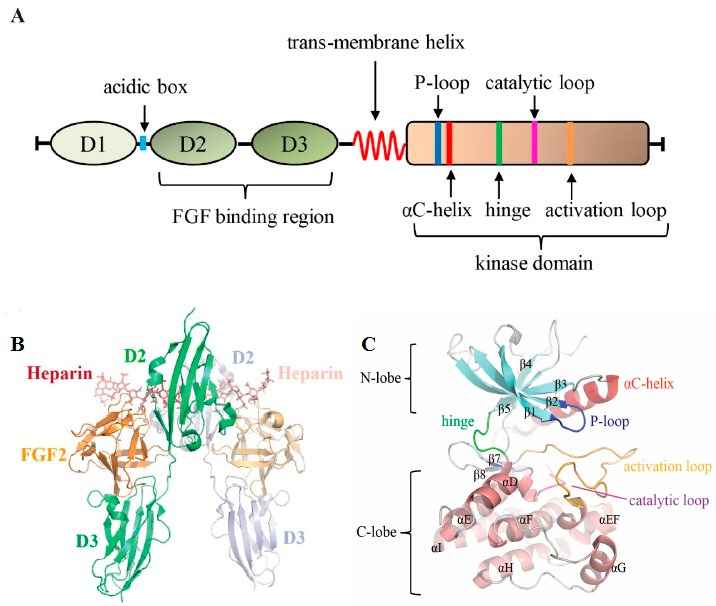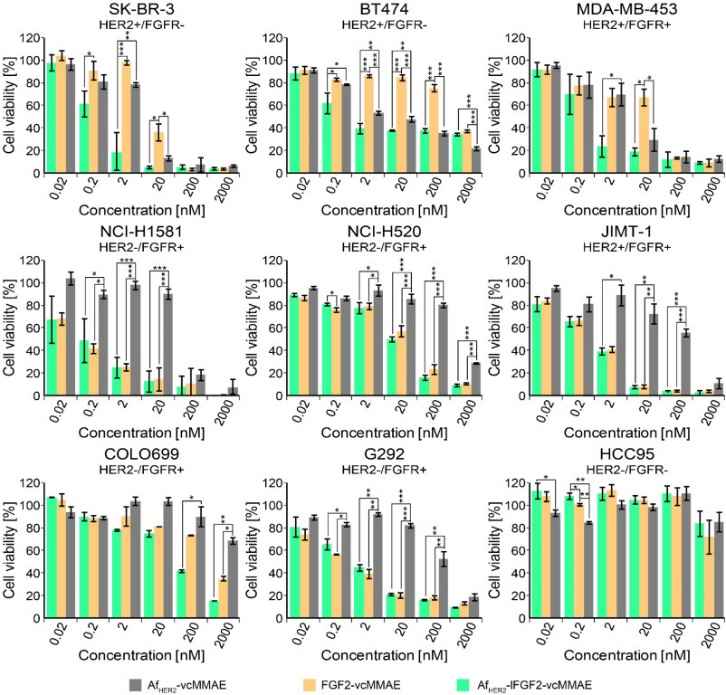- Home
- UTC Development
- Bispecific ADC Development
- Fast-internalizing Receptor based Bispecific ADC Development
- FGFR based Bispecific ADC Development
FGFR based Bispecific ADC Development Service
Bispecific antibody-drug conjugate (ADC) represents an attractive and novel therapy, which directly targets tumor-associated cell-surface antigens and provides targeted cytotoxic drug delivery with improved potency and reduced non-specific cytotoxic effects. With years' experience in antibody discovery and ADC construction, Creative Biolabs now provides our worldwide clients with a comprehensive set of customized bispecific ADC development services to achieve your goals.
Background
The Overview of FGFR
The human fibroblast growth factor receptor (FGFR) family consists of four members: FGFR1 to FGFR4. The four FGFR members share high homology, with their sequence identity varying from 56% to 71%. Similar to other receptor tyrosine kinases (RTKs), FGFRs are expressed on the cell membrane and can be stimulated and activated by extracellular signals. The native ligand of FGFRs is fibroblast growth factors (FGFs). The binding of FGFs drives the dimerization of FGFRs, subsequently, a transautophosphorylation event of the intracellular kinase domain is induced, followed by the activation of downstream transduction pathways. Through triggering downstream signaling pathways, FGFRs participate in various vital physiological processes, such as proliferation, differentiation, cell migration, and survival.
FGFRs share a canonical RTK architecture. From the N- to the C-terminus, all four FGFR members contain a large extracellular ligand-binding domain that comprises three immunoglobulin (Ig)-like subunits (D1, D2, and D3) followed by a single transmembrane helix and an intracellular tyrosine kinase domain.
- The linker region between D1 and D2 contains a highly conserved motif that is rich in aspartate acids, called the acid box.
- The FGF binding pocket is formed by the D2 and D3 subregions. The intracellular tyrosine kinase domain is the most well studied region of the FGFR protein. This domain exhibits the canonical bilobed architecture of protein kinases.
- The fold of the N-terminal small lobe consists of a five-stranded antiparallel β-sheet and the αC-helix, an important regulatory element.
- The C-terminal large lobe predominately comprises seven a helix. The active site, which is responsible for ATP and substrate protein binding, is located in a clef between the two lobes.
 Fig.1 Schematic diagram of FGFRs and the structure of the FGFR domain. (Heidi, 2011).1
Fig.1 Schematic diagram of FGFRs and the structure of the FGFR domain. (Heidi, 2011).1
Antibodies-based Therapeutics Targeting FGFRs
The ectodomains of FGFRs have attracted intensive interest in drug discovery. The dominant strategy to target FGFR ectodomains is using monoclonal antibody/antibody-drug conjugate. Several anti-FGFR monoclonal antibodies have been developed. Unlike the highly conserved kinase domain, the ectodomains of FGFRs are less conserved, antibody-targeting this domain may offer better selectivity. Phase I clinical trials involving several antibody-based drugs, including BAY1187982, FP-1039, MFGR1877S, and U3-1784, have been either completed or terminated. Of these agents, FP-1039 was reported to be well tolerated. Furthermore, trials involving bemarituzumab and B-701 have both provided preliminary data suggesting promising efficacy in patients with gastric cancers harboring FGFR2b overexpression and in those with urothelial carcinomas harboring FGFR3 alterations, but both agents currently remain in the early stages of clinical development.
Our Service
FGFR-based Bispecific ADCs Services
Creative Biolabs is a leading ADC development company that serves the global market. With our unparalleled expertise in this field, we are dedicated to providing high quality bispecific ADC candidates for our clients all over the world. If you are interested in FGFR-based bispecific ADCs development services, please do not hesitate to inquire us for more details.
Highlights
- Extensive Expertise: Leveraging years of experience in antibody discovery and ADC construction, Creative Biolabs offers a comprehensive range of customized bispecific ADC development services, tailored to meet specific research and therapeutic goals.
- Advanced FGFR Targeting: Our FGFR-based bispecific ADCs utilize the unique structural features of FGFRs, including the extracellular ligand-binding domain and the intracellular tyrosine kinase domain, to develop highly specific and effective therapeutic agents.
- Innovative Therapeutics: The bispecific ADCs target less conserved ectodomains of FGFRs, offering better selectivity and potentially superior therapeutic outcomes compared to targeting the highly conserved kinase domains.
- Global Clientele: Serving a diverse range of clients from research institutions to biotech companies worldwide, Creative Biolabs is committed to delivering high-quality FGFR-based bispecific ADC candidates that meet the highest standards.
- Customized Solutions: Our FGFR-based bispecific ADC development services are designed to provide tailored solutions, addressing the specific needs of each project to ensure optimal results and successful therapeutic advancements.
FAQ
-
Q: Why is FGFR an important target in cancer treatment?
A: FGFRs are involved in various physiological processes such as cell proliferation, differentiation, migration, and survival. Overexpression or mutation of FGFRs is associated with the development and progression of several cancers, making them a critical target for therapeutic interventions like bispecific ADCs.
-
Q: How does Creative Biolabs enhance the development of FGFR-based bispecific ADCs?
A: Creative Biolabs utilizes its extensive experience in antibody discovery and ADC construction to develop high-affinity FGFR-based bispecific ADCs. Their advanced platforms and optimized conjugation strategies ensure efficient internalization, lysosomal trafficking, and potent anti-tumor activity of the ADCs.
-
Q: What are some examples of FGFR-targeting ADCs currently in development?
A: Several anti-FGFR monoclonal antibodies and ADCs are in various stages of development, including BAY1187982, FP-1039, MFGR1877S, and U3-1784. These agents have shown promising efficacy in preclinical and clinical trials, demonstrating the potential of FGFR-targeting strategies in cancer therapy.
-
Q: What services does Creative Biolabs offer for FGFR-based bispecific ADCs development?
A: Creative Biolabs provides comprehensive services for FGFR-based bispecific ADCs development, including antibody screening, DrugLnk™ custom synthesis, antibody design and conjugation, and in vitro and in vivo analysis. Their expertise ensures the development of highly effective ADCs tailored to specific project requirements.
-
Q: How does Creative Biolabs ensure the safety and efficacy of FGFR-based bispecific ADCs?
A: Creative Biolabs conducts rigorous in vitro and in vivo evaluations to assess the binding affinity, internalization rates, lysosomal trafficking, and anti-tumor activity of FGFR-based bispecific ADCs. These analyses ensure that the ADCs are both safe and effective for potential clinical applications.
Published Data
In the experiment, FGFR bispecific ADCs were developed to target both HER2 and FGFR1 receptors, which are crucial in the progression of breast cancer. The bispecific conjugate, AfHER2-lFGF2-vcMMAE, was designed to enhance therapeutic efficacy by targeting these two receptors simultaneously. The results demonstrated that this bispecific ADC exhibited significantly higher cytotoxic activity compared to monospecific counterparts. For instance, in MDA-MB-453 cells, which express both HER2 and FGFR4, the bispecific conjugate showed a 1310-fold increase in toxicity compared to the HER2-specific ADC and a 12,057-fold increase compared to the FGFR-specific ADC. This enhanced efficacy is attributed to the improved internalization and simultaneous targeting capabilities of the bispecific ADC, highlighting its potential as a powerful therapeutic agent for cancers overexpressing HER2 and FGFR1.
 Fig.2 Cytotoxic effect of conjugates on multiple cell lines.2
Fig.2 Cytotoxic effect of conjugates on multiple cell lines.2
Featured Products
Anti-FGRF ADC
| Catalog | Product Name | Antibody |
| ADC-W-051 | Anti-FGFR2 (clone 12425)-sulfo-SMCC-DM1 ADC | Human Anti-FGFR2 antibody, clone # 12425 |
| ADC-W-052 | Anti-FGFR2 (clone 12433)-sulfo-SMCC-DM1 ADC | Human Anti-FGFR2 antibody, clone # 12433 |
| ADC-W-053 | Anti-FGFR2 (clone 10164)-sulfo-SMCC-DM1 ADC | Human Anti-FGFR2 antibody, clone # 10164 |
| ADC-W-054 | Anti-FGFR2 (clone 10220)-sulfo-SMCC-DM1 ADC | Human Anti-FGFR2 antibody, clone # 10220 |
| ADC-W-055 | Anti-FGFR2 (clone 10918)-sulfo-SMCC-DM1 ADC | Human Anti-FGFR2 antibody, clone #10918 |
References
- Greulich, Heidi, and Pamela M. Pollock. "Targeting mutant fibroblast growth factor receptors in cancer." Trends in molecular medicine 17.5 (2011): 283-292.
- Krzyscik, Mateusz A., et al. "Targeting HER2 and FGFR-positive cancer cells with a bispecific cytotoxic conjugate combining anti-HER2 Affibody and FGF2." International Journal of Biological Macromolecules 254 (2024): 127657.
For Research Use Only. NOT FOR CLINICAL USE.

Online Inquiry
Welcome! For price inquiries, please feel free to contact us through the form on the left side. We will get back to you as soon as possible.
